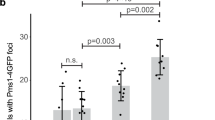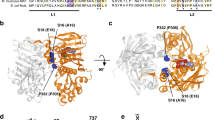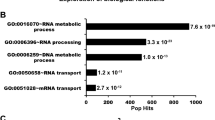Abstract
MSH2 and MLH1 have a central role in correcting mismatches in DNA occurring during DNA replication and have been implicated in the engagement of apoptosis induced by a number of cytotoxic anticancer agents. The function of MLH1 is not clearly defined, although it is required for mismatch repair (MMR) and engagement of apoptosis after certain types of DNA damage. In order to identify other partners of MLH1 that may be involved in signalling MMR or apoptosis, we used human MLH1 in yeast two-hybrid screens of normal human breast and ovarian cDNA libraries. As well as known partners of MLH1 such as PMS1, MLH3 and MBD4, we identified the carboxy terminus of the human c-MYC proto-oncogene as an interacting sequence. We demonstrate, both in vitro by yeast two-hybrid and GST-fusion pull-down experiments, as well as in vivo by coimmunoprecipitation from human tumour cell extracts, that MLH1 interacts with the c-MYC protein. We further demonstrate that the heterodimeric partner of c-MYC, MAX, interacts with a different MMR protein, MSH2, both in vitro and in vivo. Using an inducible c-MYC-ER™ fusion gene, we show that elevated c-MYC expression leads to an increased HGPRT mutation rate of Rat1 cells and an increase in the number of frameshift mutants at the HGPRT locus. The effect on HGPRT mutation rate is small (2–3-fold), but is consistent with deregulated c-MYC expression partially inhibiting MMR activity.
This is a preview of subscription content, access via your institution
Access options
Subscribe to this journal
Receive 50 print issues and online access
$259.00 per year
only $5.18 per issue
Buy this article
- Purchase on Springer Link
- Instant access to full article PDF
Prices may be subject to local taxes which are calculated during checkout



Similar content being viewed by others
References
Adachi S, Obaya AJ, Han Z, Ramos-Desimone N, Wyche J and Sedivy JM . (2001). Mol. Cell. Biol., 21, 4929–4937.
Bellacosa A, Cicchillitti L, Schepis F, Riccio A, Yeung AT, Matsumoto Y, Golemis EA, Genuardi M and Neri G . (1999). Proc. Natl. Acad. Sci. USA, 96, 3969–3974.
Bhattacharyya NP, Skandalis A, Ganesh A, Groden J and Meuth M . (1994). Proc. Natl. Acad. Sci. USA, 91, 6319–6323.
Blackwood EM, Kretzner L and Eisenman RN . (1991). Curr. Opin. Genet. Dev., 2, 227–235.
Bowers J, Tran PT, Joshi A, Liskay RM and Alani E . (2001). J. Mol. Biol., 306, 957–968.
Claij N and Te Reile H . (2002). Oncogene 21, 2873–2879.
Cole MD and McMahon SB . (1999). Oncogene, 18, 2916–2924.
Colussi C, Parlanti, E, Degan P, Aquilina G, Barnes D, Macpherson P, Karran P, Crescenzi M, Dogliotti E and Bignami M . (2002). Curr. Biol., 12, 912–918.
Crouch DH, Fisher F, Clark W, Jayaraman PS, Goding CR and Gillespie DAF . (1993). Oncogene, 8, 1849–1855.
Drummond JT, Anthoney A, Brown R and Modrich P . 1996). J. Biol. Chem., 271, 19645–19648.
Duckett DR, Drummond JT, Murchie AIH, Reardon JT, Sancar A and Lilley DM, Modrich P . (1996). Proc. Natl. Acad. Sci. USA, 93, 6443–6446.
Duckett DR, Bronstein SM, Taya Y and Modrich P . (1999). Proc. Natl. Acad. Sci. USA, 96, 12384–12388.
Eilers M, Picard D, Yamamoto KR and Bishop JM . (1989). Nature, 340, 66–68.
Felsher DW and Bishop JM . (1999). Proc. Natl. Acad. Sci. USA, 96, 3940–3944.
Gu L, Hong Y, McCulloch S, Watanabe H and Li GM . (1998). Nucl. Acids. Res., 26, 1173–1178.
Guerrette S, Acharaya S and Fishel R . (1999). J. Biol. Chem., 274, 6336–6341.
Hann SR, King MW, Bentley DL, Anderson CW and Eisenman RN . (1988). Cell, 29, 185–195.
Hardman RA, Afshari CA and Barrett JC . (2001). Cancer Res., 61, 1392–1397.
Hawn MT, Umar A, Carethers JM, Marra G, Kunkel TA, Boland CR and Koi M . (1995). Cancer Res., 55, 3721–3725.
Henriksson M and Luescher B . (1996). Adv. Cancer Res., 68, 109–182.
Holmes J, Clark S and Modrich P . (1990). Proc. Natl. Acad. Sci. USA, 87, 5837–5841.
Jiricny J . (1998). EMBO J., 17, 6427–6436.
Karran P and Hampson R . (1996). Cancer Surveys, 28, 69–85.
Kondo E, Horii A and Fukushige S . (2001). Nucl. Acids Res., 29, 1695–1702.
Kuismanen SA, Holmberg MT, Salovaara R, de la Chapelle A and Peltomaki P . (2000). Am. J. Pathol., 156, 1773–1779.
La Rocca SA, Crouch DH and Gillespie DA . (1994). Oncogene, 9, 3499–3508.
Littlewood TD, Hancock DC, Danielian PS, Parker MG and Evan GI . (1995). Nucl. Acids Res., 23, 1686–1690.
Luria SE and Delbruck M . (1943). Genetics, 28, 491–495.
Matton N, Simonetti J and Williams K . (2000). J. Biol. Chem., 275, 17808–17813.
Modrich P . (1997). J. Biol. Chem., 272, 24727–24730.
Modrich P and Lahue RS . (1996). Annu. Rev. Biochem., 65, 101–133.
Moreland NJ, Illand M, Kim YT, Paul J and Brown R . (1999). Cancer Res., 59, 2102–2106.
Mai S, Hanley-Hyde J and Fluri M . (1996). Oncogene, 12, 277–288.
Obaya AJ, Mateyak MK, Sedivy JM . (1999). Oncogene, 18, 2934–2941.
Oliver S . (2000). Nature, 403, 601–603.
Prendergast GC . (1999). Oncogene, 18, 2967–2987.
Raschle M, Marra G, Nystrom-Lahti M, Schar P and Jiricny J . (1999). J. Biol. Chem., 274, 32368–32375.
Rockwood LD, Torrey TA, Kim JS, Coleman AE, Kovalchik AL, Xiang S, Ried T, Morse HC and Janz S . (2002). Oncogene, 21, 7235–7240.
Schreiber-Agus N and DePinho RA . (1998). BioEssays, 20, 808–818.
Scully R and Livingston DM . (2000). Nature, 408, 429–432.
Strathdee G, Sansom OJ, Sim A, Clarke AR, Brown R . (2001). Oncogene, 20, 1923–1927.
Toft NJ, Winton DJ, Kelly J, Howard LA, Dekker M, te Riele H, Arends MJ, Wyllie AH, Margison GP and Clarke AR . (1999). Proc. Natl. Acad. Sci. USA, 96, 3911–3914.
Umar A, Buermeyer AB, Simon JA, Thomas DC, Clark AB, Liskay RM and Kunkel TA . (1996). Cell, 87, 65–73.
Vafa O, Wade M, Kern S, Beeche M, Pandita TK, Hampton GM and Wahl GM . (2002). Mol. Cell., 9, 1031–1044.
Yamada M, O'Regan E, Brown R and Karran P . (1997). Nucleic Acid Res., 25, 491–495.
Acknowledgements
We would like to thank Dr RN Eisenman (Seattle, WA, USA) for the pHLmyc0/1 plasmid. The MYC-ER™ cell line was kindly supplied by Dr Evan (San Francisco, CA, USA). AGH and ECM acknowledge funding from the LRF and NECCRF. EH is AICR funded and HR funded by a Glasgow University scholarship. Cancer Research UK funded MM, CJM, DHC, DAFG and RB.
Author information
Authors and Affiliations
Corresponding author
Rights and permissions
About this article
Cite this article
Partlin, M., Homer, E., Robinson, H. et al. Interactions of the DNA mismatch repair proteins MLH1 and MSH2 with c-MYC and MAX. Oncogene 22, 819–825 (2003). https://doi.org/10.1038/sj.onc.1206252
Received:
Revised:
Accepted:
Published:
Issue Date:
DOI: https://doi.org/10.1038/sj.onc.1206252
Keywords
This article is cited by
-
MYC: a multipurpose oncogene with prognostic and therapeutic implications in blood malignancies
Journal of Hematology & Oncology (2021)
-
A study of deregulated MMR pathways and anticancer potential of curcuma derivatives using computational approach
Scientific Reports (2021)
-
Association between MutL homolog 1 polymorphisms and the risk of colorectal cancer: a meta-analysis
Journal of Cancer Research and Clinical Oncology (2015)
-
Reduced migration of MLH1 deficient colon cancer cells depends on SPTAN1
Molecular Cancer (2014)
-
Mutation and association analyses of the candidate genes ESR1, ESR2, MAX, PCNA, and KAT2A in patients with unexplained MSH2-deficient tumors
Familial Cancer (2012)



